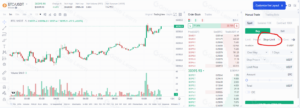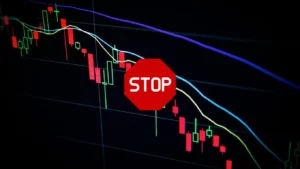
In the fast-paced world of cryptocurrency trading, managing risk is crucial to long-term success. One of the most effective tools at your disposal is the stop-loss feature, and Gate.io Stop-Loss offers a robust way to protect your investments from significant losses. Gate.io, a leading cryptocurrency exchange, allows traders to set predefined price levels at which their assets will be automatically sold. In this comprehensive guide, we’ll explore everything you need to know about using the Gate.io Stop-Loss feature, from setting it up to optimizing it for better trading outcomes.
What is a Stop-Loss Order?
Gate.io Stop-Loss order is a crucial trading instruction that triggers the automatic sale of a cryptocurrency when its price reaches a predetermined level. This threshold, set by the trader, is designed to minimize potential losses and effectively manage investment risk. The primary purpose of a Gate.io Stop-Loss order is to prevent losses exceeding the trader’s pre-defined risk tolerance for a specific trade. This is particularly important in the volatile cryptocurrency market, where prices can fluctuate rapidly and dramatically.

Why Use a Stop-Loss Feature?
Gate.io Stop-Loss orders are essential instruments in the realm of trading for a multitude of important reasons:
- Protecting Your Capital: At its core, a Gate.io Stop-Loss order acts as a safety net for your investments. By predefining a price threshold at which your position will be automatically closed, you effectively limit your potential losses on any single trade.
This is crucial for preserving your trading capital and preventing significant drawdowns, especially in the volatile cryptocurrency market. It allows you to define the maximum amount you’re willing to risk on a particular trade and stick to it. - Combating Emotional Trading: The cryptocurrency market is notorious for its rapid price swings, which can trigger strong emotional responses in traders. Fear and greed can easily cloud judgment, leading to impulsive decisions that deviate from a well-thought-out trading plan. Gate.io Stop-Loss order removes the emotional element from the equation. It acts as a pre-set, objective rule, ensuring that you exit a trade when your predetermined loss threshold is reached, regardless of how you might feel at the moment. This discipline is essential for long-term trading success.
- Promoting Peace of Mind: Trading without a stop-loss order can be a constant source of stress and anxiety. The fear of substantial losses can lead to sleepless nights and impulsive monitoring of price charts. By implementing Gate.io Stop-Loss orders, you gain a sense of control and security. Knowing that your potential losses are capped allows you to trade with greater confidence and focus on other important aspects of your trading strategy, such as market analysis and trade selection. This peace of mind is invaluable for maintaining a clear and rational approach to trading.
- Enforcing Trading Discipline: A well-defined trading plan is crucial, but it’s only effective if it’s followed consistently. Stop-loss orders play a vital role in enforcing trading discipline. They ensure that you adhere to your pre-determined exit strategy, even when market conditions become turbulent or emotions run high. This discipline is essential for avoiding costly mistakes and achieving consistent results over time. It prevents you from “moving the goalposts” and rationalizing holding onto losing trades in the hope of a turnaround, which often leads to even greater losses.
Stop-loss orders are not merely optional tools; they are fundamental components of a sound trading strategy. They protect your capital, help manage emotions, provide peace of mind, and enforce discipline—all of which are essential for navigating the complexities of the trading landscape successfully.
How to Set Up a Stop-Loss Order on Gate.io
Establishing a stop-loss order on Gate.io is an uncomplicated yet essential process for managing your cryptocurrency investments effectively. Below is a comprehensive, step-by-step guide to help you through this procedure:

- Access Your Gate.io Account: Begin by logging into your Gate.io account. If you’re a new user, you’ll need to create an account and complete the required identity verification procedures before you can begin trading.
- Navigate to the Trading Interface: Once logged in, navigate to the trading interface for the specific cryptocurrency pair you intend to trade. Gate.io’s interface typically allows you to select the trading pair from a list or search for it directly.
- Choose the Correct Order Type: This is a crucial step. Gate.io, like many exchanges, offers different types of stop-loss orders. You’ll likely encounter options such as “Stop-Limit” and “Stop-Market.”
- Stop-Market Order: This order type triggers a market order to sell your cryptocurrency as soon as the price reaches your specified “stop price.” A market order aims to execute immediately at the best available current price. Be aware that in volatile markets, the execution price might differ slightly from your stop price.
- Stop-Limit Order: This order type triggers a limit order to sell your cryptocurrency when the price reaches your specified “stop price.” A limit order will only execute if the market price is at or better than your specified “limit price.” This allows you to control the minimum price at which you’re willing to sell, but it also means your order might not fill immediately if the market moves quickly past your limit price.
- Define the Stop Price: Enter the price at which you want your Gate.io Stop-Loss order to be activated. This “stop price” is the trigger point. Carefully consider your risk tolerance and trading strategy when determining this level. Technical analysis, such as identifying support levels, can be helpful in making this decision.
- Set the Limit Price (for Stop-Limit Orders Only): If you’ve chosen a Stop-Limit order, you’ll need to specify the “limit price.” This is the minimum price at which you are willing to sell your cryptocurrency. It acts as a safeguard against selling at an unfavorable price during rapid market fluctuations. If the market price falls below your limit price after the stop price is triggered, your order will not be filled until the market price rises back to or above your limit price.
- Specify the Quantity: Enter the amount of cryptocurrency you wish to sell when the stop-loss order is triggered. This should align with your position size and risk management strategy.
- Review and Confirm: Before submitting your order, carefully review all the details, including the order type, stop price, limit price (if applicable), and quantity. Ensure everything is correct. Once you’re satisfied, confirm the order.
- Monitor Your Order: After placing your Gate.io Stop-Loss order, it’s a good practice to monitor its status. You can typically do this through the “Order History” or “Open Orders” section of the Gate.io platform.
By adhering to these steps diligently, you can effectively leverage stop-loss orders on Gate.io to manage your investment risks and safeguard your assets. It is also essential to select the right type of order—either Stop-Market or Stop-Limit—based on your specific trading approach and your personal tolerance for risk. Understanding the nuances between these order types can significantly impact your trading outcomes and overall success in the cryptocurrency market.
Optimizing Stop-Loss Orders: A Strategic Approach
Stop-loss orders are a crucial risk management tool for traders, acting as a protective measure against potential investment losses. However, simply placing a Gate.io Stop-Loss order is not enough. Effective utilization requires careful planning and precise execution to maximize its benefits and minimize its drawbacks. A strategic approach is essential, considering factors like current market conditions, inherent volatility, and the trader’s individual investment objectives. This involves determining the optimal stop-loss level, balancing technical analysis with personal risk tolerance. Furthermore, regular review and adjustment of stop-loss orders in response to evolving market dynamics are crucial for maintaining their effectiveness. In short, while stop-loss orders are invaluable, their true power lies in their thoughtful and informed implementation, enabling traders to better protect their capital and navigate the complexities of financial markets.

Strategic Stop-Loss Placement
Effective Gate.io Stop-Loss placement is paramount. Moving beyond simple percentage-based stops, traders should prioritize volatility-based approaches. Analyzing the asset’s Average True Range (ATR) or historical volatility provides valuable insights into typical price fluctuations. A stop-loss set too tightly within this range risks premature triggering due to normal market swings, cutting potential profits short. Technical analysis plays a crucial role here. Identifying key support and resistance levels allows for strategic placement: just below support for long positions and just above resistance for short positions. These levels often represent natural barriers, and a break beyond them can signal a trend reversal. Furthermore, incorporating chart patterns (e.g., head and shoulders, triangles) and technical indicators (e.g., moving averages, RSI) can refine stop-loss placement by identifying potential reversal points.
Trailing Stop-Loss Orders: Locking in Profits
Trailing Gate.io Stop-Loss orders offer a dynamic approach to risk management, automatically adjusting as the price moves favorably. This allows traders to “lock in” profits while staying in the trade to capture further upside potential. Different trailing stop types exist, including fixed trailing stops (maintaining a constant distance from the highest/lowest price) and percentage trailing stops (trailing by a fixed percentage). Selecting the appropriate type depends on the trader’s style and the asset’s volatility. Crucially, volatility must be considered when setting trailing stop parameters. Highly volatile assets require wider trailing stops to avoid premature triggering, while less volatile assets may allow for tighter stops.
Market Monitoring and Dynamic Adjustments
The market is a dynamic entity, and a static Gate.io Stop-Loss strategy is often insufficient. Regular monitoring of market conditions, news events, and economic data releases is essential. Unexpected events can significantly impact prices, necessitating adjustments to stop-loss levels. Traders must be prepared to adapt to changes in market volatility. Increased volatility may warrant widening stop-loss levels to avoid being “shaken out” by erratic price movements, while decreased volatility might allow for tightening stops to protect profits more closely. Manual adjustments based on market assessment are also crucial. Rigid adherence to pre-set levels can be detrimental in rapidly changing market conditions.
Comprehensive Risk Management
Gate.io Stop-Loss orders are just one component of a comprehensive risk management strategy. Proper position sizing is equally critical. Determining the maximum acceptable loss per trade and sizing positions accordingly is fundamental. Combining stop-loss orders with take-profit orders allows for defining a clear risk-reward ratio. A well-placed take-profit order enables securing profits when the target price is reached. Finally, diversifying the portfolio across different assets and sectors further mitigates risk.
Backtesting and Refinement
Backtesting Gate.io Stop-Loss strategies using historical data is essential for evaluating their effectiveness and identifying potential weaknesses. This process allows traders to refine their approach and optimize stop-loss parameters for various market conditions. Trading is a continuous learning process, and regular review of trading performance, including stop-loss strategy effectiveness, is crucial. Adjustments should be made as needed based on experience and market analysis.
Navigating the Minefield: Mastering Stop-Loss Orders and Avoiding Common Traps
Stop-loss orders are indispensable tools for managing risk in trading, acting as a safety net to limit potential losses. However, their effectiveness hinges on careful implementation and a deep understanding of market dynamics. Simply placing a Gate.io Stop-Loss order isn’t enough; avoiding common pitfalls is crucial to maximizing its benefits and preventing unintended consequences. A well-executed stop-loss strategy is a cornerstone of prudent trading, but it requires more than just a basic understanding of its function.

The “Too Tight” Trap: Premature Ejection from Profitable Trades
One of the most pervasive errors is setting stop-loss orders too close to the current market price. This “hair-trigger” approach often results in premature exits due to normal market fluctuations, even if the underlying trend remains favorable. The primary culprit is a failure to adequately account for the asset’s inherent volatility. Every asset experiences price swings, and a Gate.io Stop-Loss placed too tightly within this typical range is almost guaranteed to be triggered, cutting short potential profits and potentially turning winning trades into losers. Consider the asset’s Average True Range (ATR) or the standard deviation of its price movements over a relevant period. A stop-loss set within this typical fluctuation is likely to be activated prematurely. Instead, the stop-loss should be placed outside of this normal range, allowing the trade room to breathe.
Ignoring Volatility: A Recipe for Trading Disaster
Market volatility is not a constant; it ebbs and flows like the tides. Failing to recognize and adapt to these dynamic shifts can be highly detrimental. In periods of heightened volatility, prices can fluctuate dramatically, triggering even seemingly well-placed Gate.io Stop-Loss orders. Conversely, in low-volatility environments, a wider stop-loss might be unnecessarily exposing your capital to risk. Volatility can be measured using indicators like the Average True Range (ATR), Bollinger Bands, or by observing historical price movements. Furthermore, it’s crucial to understand that volatility itself can change rapidly, often triggered by news events or market sentiment.
The Illusion of Control: The Perils of Stop-Loss Over-Reliance
Gate.io Stop-Loss orders are a vital component of a comprehensive risk management strategy, but they should never be considered a panacea. Over-reliance on stop-losses can create a false sense of security, leading to the neglect of other crucial risk management practices. Remember, a stop-loss order is simply an instruction to sell; it doesn’t guarantee a specific execution price. In fast-moving markets, “slippage” can occur, where the actual sell price is lower than the intended stop-loss level. Furthermore, price gaps can lead to losses exceeding the intended stop-loss, particularly during overnight or weekend market events when trading is halted. These gaps can occur due to significant news or fundamental changes.
The “Set It and Forget It” Fallacy: A Path to Unnecessary Risk
Market conditions are in a perpetual state of flux. A stop-loss level that seemed appropriate yesterday might be entirely inadequate today. Adopting a “set it and forget it” mentality can expose your trades to unnecessary risk. News events, economic data releases, and shifts in market sentiment can all dramatically impact price action, rendering static stop-loss levels obsolete. Regularly reviewing and adjusting stop-loss levels based on current market conditions is vital.
Emotional Decision-Making: The Sabotage of Fear and Greed
Fear and greed are powerful emotions that can significantly cloud trading judgment, particularly when it comes to stop-loss decisions. Fear might lead you to set your stop-loss orders too tight, constantly second-guessing your positions and potentially missing out on substantial gains. Conversely, greed might tempt you to ignore warning signs, avoid setting a stop-loss altogether, and hold onto losing trades for too long, hoping for a miraculous turnaround that may never materialize. This emotional rollercoaster can lead to significant financial losses. A disciplined approach, based on a pre-defined trading plan, is essential.
Lack of Backtesting and Optimization: Flying Blind
Implementing a Gate.io Stop-Loss strategy without thorough backtesting is like navigating uncharted waters without a map. Backtesting involves applying your stop-loss strategy to historical data to assess its performance under various market conditions. This process can reveal potential weaknesses in your approach and help you optimize your stop-loss parameters for different assets and market environments. Without backtesting, you’re essentially gambling with your capital. It’s important to use a statistically significant amount of data and to test under different market regimes (e.g., bull markets, bear markets, and periods of high volatility).
Neglecting Position Sizing: The Magnifying Glass of Losses
Even with perfectly placed Gate.io Stop-Loss orders, improper position sizing can amplify losses. If you’re risking a large percentage of your trading capital on a single trade, even a small loss can be devastating. Position sizing involves determining the appropriate number of shares or contracts to trade based on your risk tolerance and the stop-loss level. A common rule of thumb is to risk no more than 1-2% of your trading capital on any single trade. Failing to account for position sizing can turn a manageable loss into a catastrophic one.
Conclusion
Mastering the Gate.io Stop-Loss feature, or any exchange’s stop-loss tool, is paramount for navigating the volatile cryptocurrency market and safeguarding your investments. While Gate.io Stop-Loss orders offer a crucial layer of protection, their effective implementation goes beyond simply placing an order. Understanding the nuances of different order types, strategically placing Gate.io Stop-Loss levels based on volatility and technical analysis, and actively monitoring and adjusting those levels are all essential components of a robust risk management strategy.Furthermore, it’s vital to avoid common pitfalls, such as over-reliance on Gate.io Stop-Loss orders, neglecting position sizing, and allowing emotions to dictate trading decisions. By combining a thorough understanding of the Gate.io Stop-Loss mechanism with a disciplined and adaptable approach to risk management, traders can significantly enhance their chances of success in the dynamic world of cryptocurrency trading and protect their capital in the long run.Remember that continuous learning, backtesting, and refinement are key to maximizing the benefits of Gate.io Stop-Loss orders and achieving consistent profitability.























